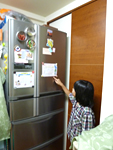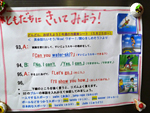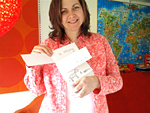 |
Lesley Ito
Originally from Florida, Lesley Ito has been involved with ELT in Japan for 18 years. She is the owner of BIG BOW English Lab in Nagoya, the author of the WE CAN! Teacher's Guides and has made numerous teacher training presentations all over Japan, from Hokkaido to Kyushu. She has also written numerous articles on teaching young learners and is active in teaching organizations in Japan. Currently she is the Program Director of JALT Junior and the
Program Chair of the TC SIG.
|
 |
|
 |
Fun with the WE CAN!
【No. 8:】Involving the parents can motivate students to study English
Also Sharing ideas by Sumako Yamashita, We Can Kid’s English, Kanagawa |
 |
Our new idea for this month’s blog comes from Sumako Yamashita, the owner of We Can Kid’s English. She wanted to find a good way to get the students to practice English outside of the classroom and so she came up with a program called “Refrigerator Notes”. She regularly sends the students home with a half A4 size sheet of paper with about four lines of English phrases the students need to learn, such as a short conversation. She also brightens up this paper with some illustrations to go with the phrases (I’d have to use clip art since I cannot draw well!) and underlines the words in the conversation to show which words need to be stressed.
 This paper is to be put on the front of the refrigerator, so everyone in the family can see it. As you know, the refrigerator is the place where family members often gather (at least, that is the case in my house!) and with this paper so prominently displayed, it is very easy for students to casually practice the phrases with their family members. Yamashita-sensei even gives the students a cute magnet at the beginning of the year to encourage her students do this! Some teachers may be reluctant to let the family members, who often cannot speak English well, practice English with their students because they are concerned about possible effects on pronunciation. However, Yamashita-sensei gets around this problem well by asking the parents at the beginning of the year to please let the students teach them the correct pronunciation and use of gestures. This paper is to be put on the front of the refrigerator, so everyone in the family can see it. As you know, the refrigerator is the place where family members often gather (at least, that is the case in my house!) and with this paper so prominently displayed, it is very easy for students to casually practice the phrases with their family members. Yamashita-sensei even gives the students a cute magnet at the beginning of the year to encourage her students do this! Some teachers may be reluctant to let the family members, who often cannot speak English well, practice English with their students because they are concerned about possible effects on pronunciation. However, Yamashita-sensei gets around this problem well by asking the parents at the beginning of the year to please let the students teach them the correct pronunciation and use of gestures.
 Of course, follow up is very important to make this program work well throughout the year, so she often asks the students if they practiced their Refrigerator Notes at home. Furthermore, the sheet is reviewed at the beginning of the next class and students are asked to practice with a partner in front of the class. The student who gives the best “performance” is given a sticker! Thank you very much, Yamashita-sensei, for sharing your idea with us and your Kai and Eva puppets are on their way to you. Of course, follow up is very important to make this program work well throughout the year, so she often asks the students if they practiced their Refrigerator Notes at home. Furthermore, the sheet is reviewed at the beginning of the next class and students are asked to practice with a partner in front of the class. The student who gives the best “performance” is given a sticker! Thank you very much, Yamashita-sensei, for sharing your idea with us and your Kai and Eva puppets are on their way to you.
If you would like to win some Kai and Eva puppets, please share your We Can! teaching idea with us. Please send your ideas to info@wecanenglish.jp.
I think Yamashita-sensei’s idea is great because not only does it allow students extra practice with the lessons in the textbook, it also shows the parents that their children are really learning English. As we all know, parental assessment often takes the form of suddenly demanding the child to, “Say something in English!” The child freezes up, says nothing and then the parent wrongly concludes that the child cannot speak English. If we want the parents to understand what we are doing in the classroom, we have to be proactive and provide them with ways to see how their child is progressing. One way is through proper assessment: the Goals of We Can!, tests or homework. It is also helpful to create situations where their “English World” inside the classroom touches their everyday life. Students can speak English in front of their family members only if support is provided. One very enjoyable way of providing support is through the use of Flap Books. In the We Can Teacher’s Guides, I often recommended using these for phonics extension activities, but they work well to help students talk about what they have learned.
To make a Flap Book, you need a piece of paper (construction paper works best, but any kind of unlined paper will work well), a pair of scissors and colored pencils. Students fold the paper in half, lengthwise and then cut four flaps on the top page to the center fold. (The back page should not be cut.) If you wanted to make a Flap Book reviewing language from We Can! Level 2 Units 4 (Beautiful Nature) and 5 (Wild Animals), have the students choose four animals from they two units and draw a picture of that animal on the top flap. Next to that animal, they should write “A __________” or “An ______________”. (For example, “An elephant”.) Then have them choose an adjective from page 34 that describes that animal and then write “is _________.” under the flap. (For example, “is strong.”)
 Once students have completed the Flap Book, they can use it to help them say four original sentences that describe animals. Have the students practice in front of the class and then after class, show it to the parents and let them know that their child will present it to them at home. Once students have completed the Flap Book, they can use it to help them say four original sentences that describe animals. Have the students practice in front of the class and then after class, show it to the parents and let them know that their child will present it to them at home.
It takes a little extra effort to involve the students’ families and to bring English into their homes, but making this extra effort will really pay off in the long run!
|
|



